How to choose paintable ceiling plaster?

Ceiling putty for painting is needed in order to remove all defects that are on the surface. This work must be carried out in several stages. If you putty as high as possible, focusing on certain rules, the base will be ready for any finishing. However, not everyone knows how to choose the most suitable filler material.

What is it for?
Renovation work in an apartment or house is usually planned, not spontaneous. The reasons can be different: the desire to update the interior with the help of cosmetic repairs, the need for finishing work in a newly built house. In any of these cases, before painting the ceiling surfaces, you will first need to apply a putty material to them. With paint alone, you will not hide the unevenness on the ceiling, but only make them more noticeable.
After the putty, the surface will become as flat as possible and perfectly prepared for the application of paint and varnish coatings.


New living quarters after construction work often have a large number of imperfections. Sometimes workers can inaccurately apply the plaster. In this case, using a putty can be ideal. However, such material will not be able to cope with significant altitude differences. In such situations, it is worth stopping the choice on other methods, for example, making a suspended ceiling.


Choosing the right material
It is necessary to choose the material, the characteristics of which are best suited to the particular room and conditions of its use.
Some putty compounds are sold ready-made, but there are also putties, which are dry mixes.


For people who have little experience in applying putty materials with their own hands or for beginners who are starting repairs for the first time, it is usually difficult to immediately choose the best option. To facilitate the task, you should understand the features of specific types of plaster. When deciding on the choice, take into account the following nuances:
- There are many filler materials on the market that are designed for specific surfaces. Many packages indicate: for concrete, for drywall, and so on.

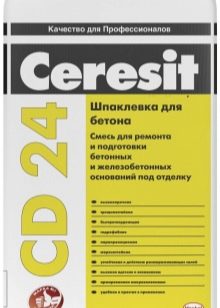

- Putty mixtures differ in the composition of the base ingredients and additional components that affect the characteristics of the use of the product. For example, the presence of plasticizers provides plasticity to the solution, and after drying, the likelihood of cracks on the ceiling decreases.


- On sale there are putties, which are focused on use in individual rooms. The packaging may indicate the operating conditions - for rooms with high humidity, which is important for the bathroom and kitchen. Mention the high rates of a separate property - it has increased moisture resistance, increased fire resistance, and the like. The putty for painting itself must be resistant to liquid.




If you cannot independently determine the type and amount of material, contact the consultants in the store for help. Some do not take into account that the putty is a finishing and starting compound, and only use the same type of compounds.It is not recommended to do this, otherwise the coating will turn out to be of poor quality and short-lived.


Required tools
It is recommended to immediately prepare the tools that will be needed for all work with the ceiling: for priming, puttying, painting. The list includes:
- protective mask or respirator;
- grinder, with which you can clean the ceiling and expand the cracks;
- building level;
- spatulas;
- mixer nozzle and electric drill;
- various brushes;
- containers for materials used;
- sandpaper, abrasive nets;
- roller.






Surface treatment technology
Do not immediately apply the filler to the ceiling, but first carefully prepare the surface. All old coatings should be removed from the base, then cleaned from the formed dust. Then apply a primer, usually two coats are sufficient.
There should be no whitewash, pieces of wallpaper, old paint on the ceiling. Whitewashing can be removed using a wet brush.
Wet the surface, wait a few minutes and remove the coating with a metal spatula.


To remove old obi, wet them with a damp cloth or brush, after which they can be easily removed using a tool that is convenient for you. In some cases, it is necessary to repeat the procedure to remove all coating residues from the surface.
The most difficult thing to remove from the ceiling is paint. Removing the paintwork manually will not work; you will have to use a special device - a grinder. With its help, you can effortlessly get rid of all layers. However, in some cases, a conventional spatula is sufficient to remove paint and varnish material.


Dust must be removed from the ceiling when there are no old coatings on it. For this, it is recommended to use a vacuum cleaner with a soft attachment. With the help of such a device, you can do everything as easily and quickly as possible. If this is not an option for you, you can use a regular broom or a soft bristled brush.
When the dust has disappeared from the surface, you will need to wipe it off using a damp cloth. By doing so, you will be able to prevent unevenness when applying the primer.

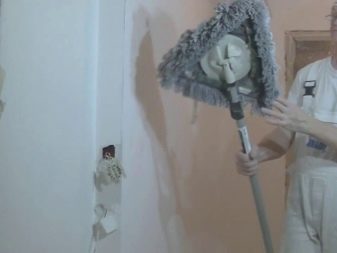
Mix preparation
For all putty materials, certain proportions are provided. When preparing water into a solution, you must be guided by the recommendations that are indicated in the instructions. However, in most cases, it is retained for putties. general training principle:
- The dry mixture is mixed with water in a prepared container.
- Then everything is mixed with an electric drill. The solution should be completely homogeneous.


- To make the surface flawlessly even, you need a thick enough filler material. For the finishing and starting coatings, a creamy mixture will be prepared.
- With a gypsum base, a small portion of the solution will be needed, since the gypsum hardens quickly enough. If you neglect and prepare a large amount of putty, it will harden, it will become impossible to use it, and the container, bucket or container will have to be thrown away. You can find out how long the mixture "lives" from the instructions on the package.


Start layer
When the surface is clean and dry, you can start applying the starter coat. The solution for it must be pasty (prepare the material as indicated above). You need to apply the starting putty as follows:
- Using a narrow spatula, draw up the required amount of material from the container. It should be spread evenly over a wide spatula. Starting at the corner, apply the filler to the ceiling.
- Press the tool firmly against the ceiling, so the material can hide and fill every groove, literally pressing into the surface. The starter layer should not be thick. You can even make the ceiling shine through the putty. The first layer is designed to close small defects.


- Make the floor as smooth as possible. There should be no protruding stripes on the boundaries of the zones.
- After applying the starting layer, after waiting for it to dry, the ceiling must be wiped using an abrasive mesh, a float. Movements should be circular, direction - counterclockwise. You should exercise the utmost care: do not miss a single spot on the ceiling, the entire surface should be treated.
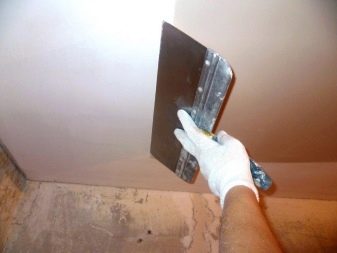

- To better control the evenness of certain places, you can use a light bulb, with its help you will highlight the necessary areas. Experts work with the putty composition so that the number of defects is minimal. This process is especially important if you are going to make the other layer not very thick.
- If necessary, after grouting, add an additional starter layer of putty. The total thickness should not exceed 12 mm.

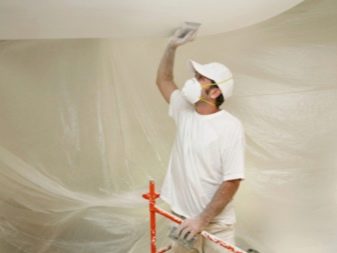
- Wait until it is completely dry. The term depends on the thickness of the coating and the composition of the solution. Then you will need to carry out another grout. It should be more careful than the previous ones, since the surface needs to be made as flat as possible.
- After all work, dust is removed from the ceiling, a primer is applied to the surface again.

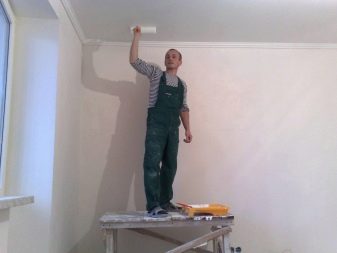
Finish coating
The finishing putty should be more flexible than the starting one. With this material, you should make the surface as smooth as possible. In terms of consistency, the finishing compositions can be compared with very thick sour cream.
Such the putty should be applied in smooth circular and straight movements, starting from the wall. It is not recommended to press the instrument too hard against the ceiling. If necessary, when the first finishing coat dries, apply another, thin enough. Grout should be done after each layer.
The last coating will need not only to be wiped, but also sanded using fine-grained sandpaper and a float.


To make the ceiling as smooth as possible, acrylic rather than gypsum putty is often used to apply the last layer. The thickness should not exceed 1.5 mm. To apply acrylic, use a trowel without sharp corners to avoid noticeable streaks on the surface.


Final works
After the final putty has completely dried, the surface must be prepared for applying paint. First sand the ceiling using sandpaper or mesh. To find all defects, close the windows and shine a flashlight on the surface. Shine should be at an angle. After sanding, the ceiling will be as flat as possible.
Before applying the paint, the surface will need to be primed again. It should be applied to the ceiling with a roller in two layers. Allow the first coat to dry completely before the second coat of primer.


Helpful hints
The corners between the ceiling and walls should be treated with particular care. Sanding in such places should be done with the utmost care.
Make sure to properly prepare the surface before using water-based paint or any other paint. It so happens that the coating falls off over time from a poorly prepared surface. It is necessary to align, clean the ceiling, there should be no defects on it.


You should choose a filler material that is best suited for a specific room and for a specific surface. Many sellers recommend opting for a universal putty, however, it should be borne in mind that such options are not suitable in all cases. When choosing the right material, you need to focus on your own experience or on the recommendations of experienced craftsmen.
For information on how to properly make the ceiling putty, see the next video.













I used a ready-made finish from Polyfila. Then the paint applied well to her
The comment was sent successfully.